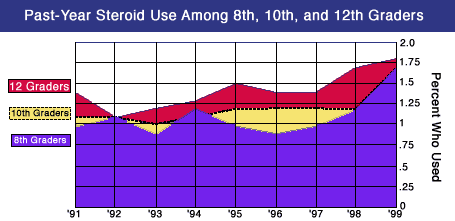Overall Teen Drug Use Stays Level, Use of MDMA and Steroids Increases
Download PDF Version What is PDF?
Steven Stocker
Steven Stocker is a Contributing Writer for NIDA NOTES.
Source: NIDA
NOTES, Vol. 15, No. 1, March
, 2000
Public Domain
Table of Contents (TOC)
Overall Teen Drug Use Stays Level, Use of MDMA and Steroids IncreasesDrug use among the Nation’s adolescents generally held steady in 1999 with the exception of MDMA, or "ecstasy," and steroids, according to the most recent Monitoring the Future study. This annual study, supported by NIDA and conducted by the Institute for Social Research at the University of Michigan in Ann Arbor, surveys drug use among 8th-, 10th- and 12th-graders in the United States.
Secretary of Health and Human Services Dr. Donna E. Shalala presented the results of the study at a press conference in Washington, D.C., in December. She noted that for the third year in a row adolescent drug use rates stayed the same or declined after the rapid rise in the early 1990s. "Today’s report confirms what we’ve suspected for some time: that the trend of increased drug use among America’s young people is grinding to a halt," she said. Also participating in the press conference were White House Drug Policy Director General Barry McCaffrey, NIDA Director Dr. Alan I. Leshner, and principal investigator Dr. Lloyd Johnston of the University of Michigan.
 |
Although no significant changes occurred in 1999 in the use of marijuana, amphetamines, hallucinogens, tranquilizers, or heroin, several significant changes in other drug use did occur, including:
- a reduction in the use of crack cocaine by 8th- and 10th-graders, following several years of gradually increasing use;
- a reduction in the use of crystal methamphetamine, or "ice," among 12th-graders, reaching the lowest level in 5 years;
- a reduction in cigarette smoking among 8th-graders;
- an increase in the use of MDMA among 10th- and 12th-graders; and
- an increase in the use of anabolic steroids among 8th- and 10th- graders, primarily among boys.
Anabolic steroids are synthetic derivatives of the male hormone testosterone that promote skeletal muscle growth. They have legitimate medical uses but sometimes are used illegally to enhance athletic performance and improve physical appearance. Side effects can include liver tumors, high blood pressure, wild mood swings, and violent behavior.
 Referring to the increase in MDMA use, Dr. Johnston said that the forces
that help spread the use of a new drug by adolescents generally work
more quickly than the forces that help to contain its use. "When a newer
drug comes onto the scene, young people hear much more about its supposed
benefits than about its potential harms," he said. "It can take some
time for evidence of the adverse consequences to become known to them." General
McCaffrey noted that many adolescents imagine that MDMA is a relatively
safe drug, but recent NIDA-funded studies show that it may cause long-term
brain damage.
Referring to the increase in MDMA use, Dr. Johnston said that the forces
that help spread the use of a new drug by adolescents generally work
more quickly than the forces that help to contain its use. "When a newer
drug comes onto the scene, young people hear much more about its supposed
benefits than about its potential harms," he said. "It can take some
time for evidence of the adverse consequences to become known to them." General
McCaffrey noted that many adolescents imagine that MDMA is a relatively
safe drug, but recent NIDA-funded studies show that it may cause long-term
brain damage.
MDMA is one of several drugs that are known collectively as "club drugs" because they are used at dance clubs and all-night dance parties called "raves." Other club drugs include LSD, GHB, Rohypnol, methamphetamine, and ketamine. NIDA recently announced an increase of 40 percent in its funding for research on club drugs. It has also joined with other national organizations on a multimedia campaign to educate the public about the dangers of using these drugs.


